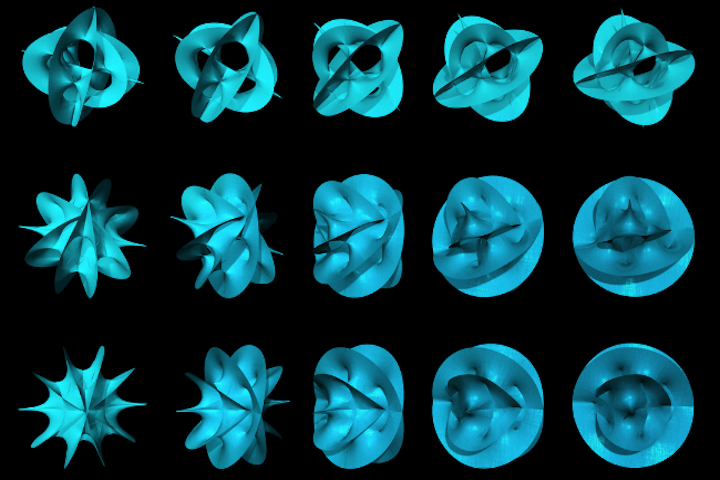String theory, the candidate for theory of everything

What is string theory
String theory describes interactions and particles as dynamic relativistic vibrating strings .
It is the best candidate to become the theory of everything since Einstein's theory of general relativity and many of the aspects of quantum mechanics are born naturally from it.
Therefore, a quark and an electron would be strings that vibrate in different modes. Furthermore, these strings live in a world of 10 spatial dimensions and 1 temporal dimension.
According to the string model, 6 dimensions would be compactified in mathematical spaces called Calabi-Yau.
The concept of supersymmetry is also included in the theory, becoming superstring theory.
Today we will talk about
History of string theory
During the 1960s there were certain results of the strong nuclear interaction that could not be explained by the theoretical physics of the time.
TO Italian physicist named Gabriele Veneziano I found an ancient math function called Euler beta function , which coincidentally described these experimental results of the strong nuclear force.
Birth of the rope concept
From these results by Veneziano, physicists such as Leonard Susskind or Yoichiro Nambu related the Euler beta function model as a relativistic vibrating string theory. Different modes of vibration would give rise to different subatomic particles.
First superstring revolution
At first it seemed that we might be facing a theory that could explain the foundations of all existing theories. However, problems soon appeared.
This model gave rise to a concept known as ghosts . Ghosts are events that result in negative probabilities, incompatible with quantum mechanics.
Another problem was that this theory It only described the behavior of bosons and not fermions , essential constituents of matter.
The problem of ghosts was solved considering that string theory lived in a 26-dimensional space . However, this did not please the theoretical physicists of the time very much since according to our experience we live in a three-dimensional universe.
To solve this problem the concept of supersymmetry was introduced . Supersymmetry related bosons and fermions so that each fermion had a bosonic superpartner and each boson a fermionic superpartner.
For example, The supersymmetric partner of the electron is the selectron and the photon's fermionic superpartner the photino.
This concept of supersymmetry reduced the dimensions from 26 to 10 and also made room for fermions within the theory.
Between 1984 and 1986 there were a series of advances in string theory with which it was understood that this model could describe all particles and their interactions at a more fundamental level. The pioneers of this superstring revolution were physicists Michael Green and John Schwarz.
During these years, different superstring theories also emerged, specifically 5.
Second superstring revolution
During the 80s 5 different theories emerged of strings, each with its own peculiarities. Physicists did not understand all the diversity of models that were emerging.
Between 1994 and 1997, many advances took place that solved this problem. This period is today called the second superstring revolution.
Theoretical physicists discovered that the 5 existing string theories actually They were different sides of the same coin. and that they were all related through mathematical transformations called dualities.
Some examples are S-duality, T-duality or U-duality .
These mathematical aspects are outside the scope of this publication since they require advanced knowledge of mathematics.
The 5 superstring theories
As we have seen, there are different ways to model superstring theory. All of them are related to each other through mathematical transformations.
Type I string theory
This model was described by Michael Green and John Schwarz and describes open and closed strings propagating in 10-dimensional spacetime. This type of string model also includes higher-dimensional structures called branes.
Type IIA string theory
Type IIA string theory, very similar to IIB, describes closed strings that propagate in 10 dimensions. It differs from IIB in certain symmetrical aspects of chirality.
Type IIB string theory
Like the previous one, the IIB string model includes closed strings that extend in a 10-dimensional space-time. There are symmetrical differences with theory IIA.
SO(32) heterotic string theory
Heterotic strings have a part that lives in 10 dimensions. However, another part of the strings live in 26 dimensions. Thanks to the special orthogonal symmetry group of 32 dimensions we can mathematically manipulate 16 of the 26 dimensions to obtain 10 dimensions again. T duality relates SO(32) and E8xE8 string theory.
Heterotic string theory E8xE8
This theory is almost the same as the previous one. In this case we use the group formed by the Cartesian product of the Lie group E8 to be able to treat those 16 extra dimensions and obtain the 10 typical dimensions of string theory.
String Theory Summary
- String theory arose from Veneziano's idea to describe the behavior of hadrons and the strong nuclear force using Euler's beta function.
- Leonard Susskind and Yoichiru Nambu interpreted Veneziano's model as vibrating strings.
- String theory had certain problems. To work well it had to be defined in 26 dimensions and there were also incompatibilities with quantum mechanics.
- The concept of supersymmetry was introduced into the model, becoming superstring theory.
- During the 80s, 5 different string models were formulated. Physicists were a little confused until they discovered that they were simply different sides of the same theory: M-theory. They were all related through mathematical transformations.

